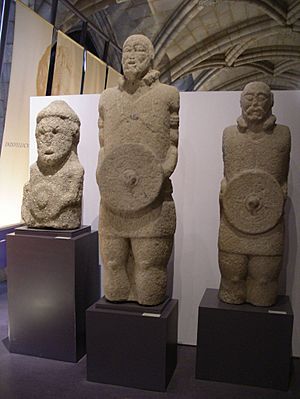Gallaecian warrior statues facts for kids
The Gallaecian warrior statues are ancient stone sculptures found in what is now Galicia in Spain and northern Portugal. These statues were made just before the Roman Empire took over the area. They are often linked to the Gallaeci people, an ancient tribe, but are also sometimes called Lusitanian or Castro Culture statues.
These impressive statues show armed men and are a bit larger than real-life size. Experts believe they represent important local heroes or leaders who were seen as gods. Most of these statues were created between 200 BCE (Before Common Era) and 100 CE (Common Era).
Contents
What Are Gallaecian Warrior Statues?
These statues are special stone carvings from a long time ago. They show warriors from the ancient Gallaeci people. These people lived in the northwest part of the Iberian Peninsula, which is now Spain and Portugal.
The statues are usually made of granite, a strong type of stone. They stand tall, often over 2 meters (about 6.5 feet) high. Each statue shows a man dressed in armor and holding weapons.
Who Made These Statues?
The Gallaeci people and other related tribes created these sculptures. They were part of the Castro culture, which was a group of communities living in fortified villages called "castros." This culture existed before the Romans arrived.
The statues show how skilled these ancient people were at carving stone. They used simple tools but created detailed and powerful figures.
What Do They Look Like?
The warrior statues usually show men with serious faces. They wear helmets, often with horns or other decorations. Their bodies are covered in armor, sometimes with scales or patterns.
They carry shields and swords, showing they were ready for battle. Some statues also show other details like belts or necklaces. The way they are carved makes them look strong and brave.
Why Were They Made?
Historians believe these statues were made for several important reasons. They were not just decorations.
Honoring Heroes
One main idea is that the statues honored important local heroes or chiefs. These might have been great warriors or leaders who protected their people. By making statues of them, the community remembered their bravery and achievements.
It was a way to keep their memory alive. It also showed respect for their power and influence.
Protecting the Community
Some experts think the statues might have been placed in special spots to protect the community. They could have been seen as guardians. Their presence might have scared away enemies or evil spirits.
They might have stood at the entrance to villages or important places. This would show visitors the strength of the people living there.
Showing Power
The statues also showed the power and wealth of the community that made them. Creating such large and detailed sculptures required a lot of effort and resources. It was a way to display their strength to other tribes.
They were a symbol of pride and identity for the Gallaeci people.
Where Were They Found?
Most Gallaecian warrior statues have been found in northwest Iberia. This area includes modern-day Galicia in Spain and northern Portugal.
They are often discovered near ancient settlements or important sites. Many are now kept in museums. This helps protect them and allows people to learn about this ancient culture.
Famous Examples
One well-known example is the "Warrior of Sanfins." It was found in Portugal. Another is the "Warrior of Lezenho." Each statue has unique details, but they all share the common theme of a powerful warrior.
These statues are important clues. They help us understand the beliefs and lives of the people who lived in this region long ago.
See also
In Spanish: Estatuas de guerreros galaicos para niños


